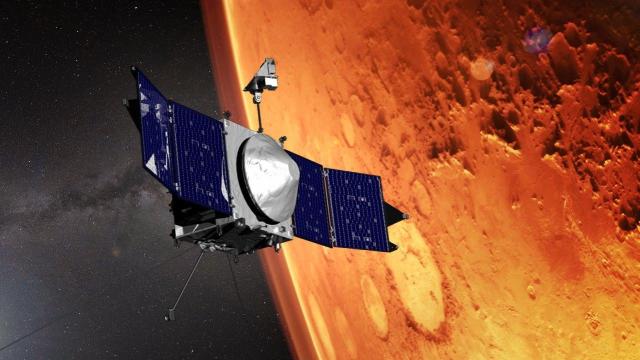NASA’s Mars Atmosphere and Volatile EvolutioN (MAVEN) spacecraft has been out of commission for most of the year, but owing to a very clever hack, the probe is now using the stars to navigate its way around the Red Planet.
The probe had been in safe mode since February, but NASA engineers successfully resolved the issue by uploading new software to the spacecraft. MAVEN resumed science and relay operations on May 28, following its recovery from an extended safe mode, according to NASA. “The team really stepped up to an existential threat,” Rich Burns, the MAVEN project manager at NASA’s Goddard Space Flight Centre, said in a statement.
Launched in November 2013, MAVEN entered its orbit around Mars in September 2014 with the goal of probing the planet for clues as to why it lost so much of its atmosphere during its early history. Understanding the process by which Mars lost copious amounts of its atmosphere is crucial to determining if the Red Planet was once habitable, as it may have potentially hosted some form of life billions of years ago.
The mission had been proceeding nicely, with the probe doing good work in the Martian orbit and with NASA extending the spacecraft’s mission duration on five different occasions. But on February 22, the team lost contact with the spacecraft.
Here’s what happened to the ageing orbiter: MAVEN ran into an issue with its Inertial Measurement Units (IMUs), which measure the spacecraft’s rotation to determine its attitude in space, or its ability to maintain or change its orientation relative to where it wants to go. There are two IMUs on the spacecraft, a primary one and a back up unit. When communication with MAVEN was restored, the ground team found the spacecraft to be disoriented and unable to determine its attitude from either of its two IMUs.
The spacecraft then entered into the ominous safe mode, which kept it floating through space while science operations were on hold. As MAVEN hibernated, the team of engineers behind the mission worked to develop a system that would allow the spacecraft to navigate, not with its IMUs, but by using stars as static reference points. The team had already been working to develop this all-stellar navigation software, but it wasn’t supposed to be ready before October. Given the dire situation, however, the spacecraft needed help from the stars sooner rather than later.
“By the time we ended up on the backup computer, the spacecraft had been attempting to fix the problem with IMU-1 for about 78 minutes,” Micheal Haggard, the Lockheed Martin MAVEN spacecraft team lead, said in a statement. “We ended up on IMU-2, and the pressure was on to get the all-stellar mode ready as quickly as possible.”
The star navigation system — thankfully five months ahead of schedule — was ready to go. On April 19, the team uplinked the software to the spacecraft, turned off the backup IMU, and switched MAVEN’s science instruments back on. MAVEN, some two days after returning to action, even managed to spot a coronal mass ejection from the Sun that impacted Mars.
This marked MAVEN’s second stint in safe mode, the first time happening shortly after its science instruments were turned on in 2014, the result of a glitch that forced it to shut down for nearly a week. Looking ahead, the spacecraft has enough fuel to last it through 2030, and its backup IMU is still there just in case MAVEN should need it from time to time.
